Native Wildflower: Jack-in-the-pulpit (Arisaema triphyllum)
Jack-in-the-pulpit, Indian turnip, arum, brown dragon, bog onion, devil’s ear, priest’s pintle, [wild, marsh, dragon, meadow turnip] (Arisaema triphyllum)
Our native jack-in-the-pulpit (Arisaema triphyllum L.) is a common long-lived wildflower that inhabits the deciduous forests of Eastern North American from Nova Scotia to the Gulf of Mexico and west to MN. Our native Arisaema is easy to spot in spring when it erupts into flower and again in late summer when it ripens a showy red fruit. Keep an eye out. You’ve probably seen Indian turnip if you walk in the Wissahickon woods and the Schuylkill Center, hike the trails in Fort Washington SP and Green Lane, or visit local gardens: Morris Arboretum, Bartram’s Garden, and Bowman’s Hill Wildflower Preserve
Georgia O’Keeffe. Jack-in-the-Pulpit No. II, 1930; oil on canvas, 40 x 30″
National Gallery of Art, Washington, D. C.
Alfred Stieglitz Collection, Bequest of Georgia O’Keeffe
In the spring of 1930 Georgia O’Keeffe discovered a colony of jack-in-the-pulpit plants (Arisaema triphyllum) blooming in the woods near her summer home in the Adirondacks at Lake George, NY. Fascinated and inspired by the weird beauty of Arisaema flowers, she painted her Jack-in-the-Pulpit Series, capturing the magical essence and botanical mystery of an unusual native wildflower. The botanical exuberance of the portraits cannot help but transmit the painter’s love of nature: “I decided that if I could paint that flower in a huge scale, you could not ignore its beauty.”
Georgia O’Keeffe. Jack-in-the-Pulpit No. III, 1930; oil on canvas, 40 x 30″
National Gallery of Art, Washington, D. C.
Alfred Stieglitz Collection, Bequest of Georgia O’Keeffe
Like a naturalist, O’Keeffe illustrates the botanical phantasm of Arisaema. If you’ve never seen Arisaema in bloom, O’Keeffe, the high priestess, pulls back the veil to expose the inner sanctum; she paints the fantastic, bizarre floral structure of Arisaema for our study. Always, the painter wants us to see: “Nobody sees a flower really; it is so small. We haven’t time, and to see takes time – like to have a friend takes time.”
Georgia O’Keeffe. Jack-in-the-Pulpit No. IV, 1930; oil on canvas, 40 x 30″
National Gallery of Art, Washington, D. C.
Alfred Stieglitz Collection, Bequest of Georgia O’Keeffe
O’Keeffe focuses on the Arisaema flower. Each painting in the series gradually magnifies the hooded spadix, which becomes increasingly abstract. Like Emily Dickinson, O’Keeffe does not anthropomorphize the natural world and the sexual life of plants, but she knows that humans, self-referential in the extreme, can’t help ourselves. The painter knows that most of us will see the spadix as (human) male and conclude that the spike or spadix within the spathe must be a male infloresence, despite the fact the male flower cannot bear fruit.
Georgia O’Keeffe. Jack-in-the-Pulpit No. V, 1930; oil on canvas, 40 x 30″
National Gallery of Art, Washington, D. C.
Alfred Stieglitz Collection, Bequest of Georgia O’Keeffe
Arisaema enjoys a fluid flowering cycle known as sequential hermaphroditism. In a young Arisaema plant, the smaller spadix is a male flower because the plant is not yet strong enough to attract pollinators or self pollinate, set fruit, and produce seed. As plants mature, female flowers must gradually dominate. The bigger the spadix, the bigger the ovary, the more successful the fruit. A mature Arisaema produces a large female spadix (infloresence), which will bear fruit, seed, and guarantee the survival of the species.
Georgia O’Keeffe. Jack-in-the-Pulpit No. VI, 1930; oil on canvas, 36 x 18″
National Gallery of Art, Washington, D. C.
Alfred Stieglitz Collection, Bequest of Georgia O’Keeffe
Art critics, who know nothing about botany, sexualized O’Keeffe’s Jack-in-the-Pulpit Series into meaningless Freudian absurdity. She loved it. Anyone who has ever studied biology or browsed Botany for Gardeners knows that O’Keeffe is messing with us.
Growing Arisaema triphyllum
I’ve had Arisaema triphyllum in the garden, but it’s never flourished like the Asian species. I suspect our native Indian turnip is less tolerant of dry soils. And even when it did bloom, the Arisaema behaved like ephemeral May apple (Podophyllum peltatum) or twin-leaf (Jeffersonia dyphylla), disappearing completely by midsummer. I haven’t seen any sign of Indian turnip this spring, so it’s probably gone.
This is not a warning. Give Arisaema triphyllum a shot if you’ve got the right conditions. Deep, rich, moist shade is the key, as it is for many Arisaema species. Nonetheless, the Asian species I grow successfully are not fussy and will tolerate far less optimal conditions and even thrive. More soon.
It’s probably time to rebrand our native Arisaema triphyllum with the much more muscular common name: Cobra lily, generally used to refer to Asian Arisaema species. I also like Indian turnip. Native Americans ate the corm like a root vegetable.
The Schuylkill Center is a great source for native plants. In addition to the annual spring sale, an early summer native plant sale is scheduled for June 28 (9:00 – 2:00). Please remind me; I missed the spring sale.

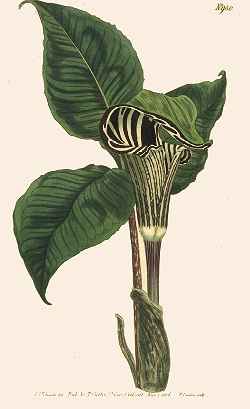


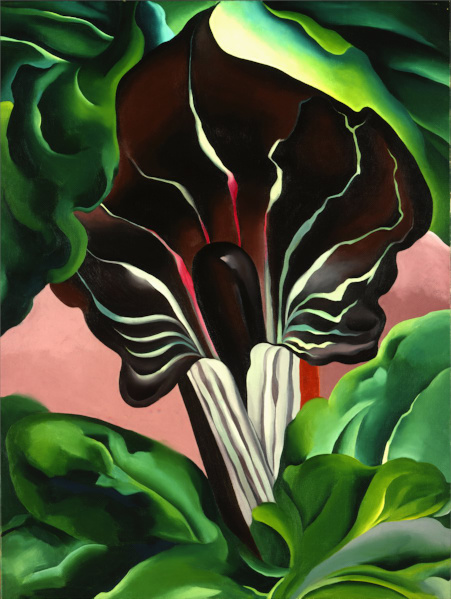


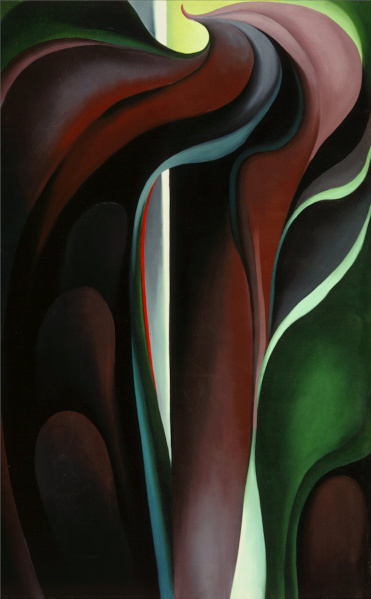
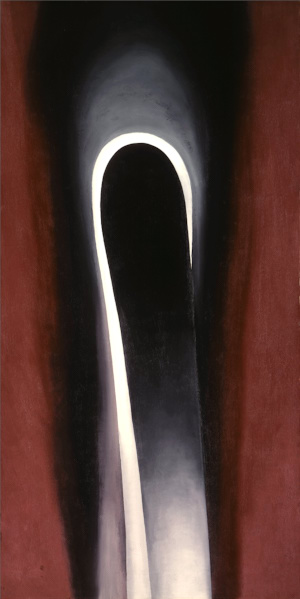

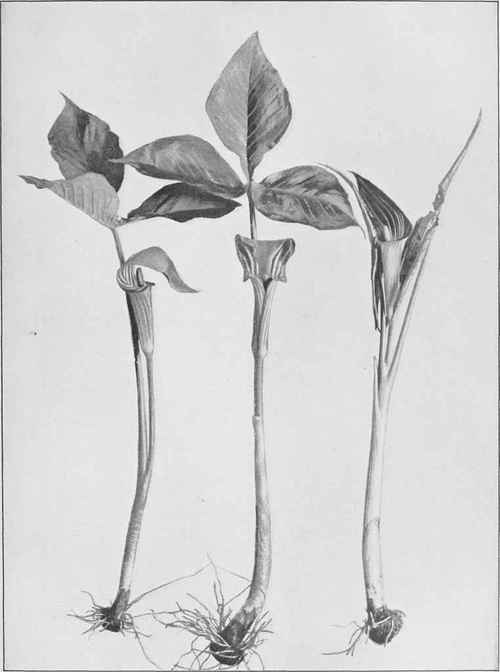

When I bicycled to school in the 4th,5th,and 6th grade I would stop on a secluded lane to find the jack- in- the -pulpits in spring.I can recall the exact spot.It felt exotic. I’m remembering unexpectedly spotting the pulpit’s bright red fruit later in the season in your garden -I’d never seen this before. Judy,How do you do it? -these spectacular creations of yours -one coming at the heels of another. Wasn’t it just a few days ago that I received your Epimedium post! I loved beginning this day with [to quote Helen] your “brilliance” and the striking paintings of Georgia O’Keefe.The pulpit’s mystery she surely captured -intensely. The first two paintings bring to mind New Mexican retablos of the Virgin of Guadeloupe. Can you see why? Her rays/ its emanating stripes- I love the slice of light in the 3rd and its stunning blues -the gorgeous earthy fluidity of the 4th and the linear,bold grace of her final piece. Again,large thanks for all you send our way. I like imagining a multitude of your and Laura’s and Janet’s Epimediums taking flight [those delicate fairy wings] in this back garden at dusk. Once I heard of a Jack-in-the-Pulpit also referred to as an American wake robin? And now, in my imagination I am traveling to your beloved JACK Russell -one thing leads to the next always. I best go get my hands in the earth this beautiful May morning.
Hey, Jane.
I never expect to see Indian turnip or any of our native wildflowers in the Wissahickon, only Japanese knot weed. But on many runs and, speaking of Beanbag, dog walks, I encountered brown dragon (A. triphyllum), usually after the bloom or in fruit when you can’t miss that red seed head. Searching carefully off the track among rock outcroppings, I also found trailing arbutus (Epigea repens), and 30 years ago it was possible to find bloodroot (Sanguinaria canadensis). I admire your success with bloodroot. I’ve never been able to keep bloodroot in the garden, but of the spring ephemerals I have established: twinleaf (Jeffersonia dyphyllum), Hepatica, May apple (Podophyllum peltatum), and Virginia bluebells (Mertensia virginica). The spring blooming perennial natives, like merrybells (Uvularia grandiflora), wild ginger (Asarum canadense), Pachysandra procumbens, Chrysogonum virginianum, Tiarella, and Heuchera are far easier, perhaps even a bit wild and spreding as groundcovers should be. But success with the ephemerals is more satisfying.
My new planting of ‘Red Riding Hood’ tulips bloomed later than ‘Fusilier’ this year, so the show was a bit staggered and unbalanced. How do your tulips grow?